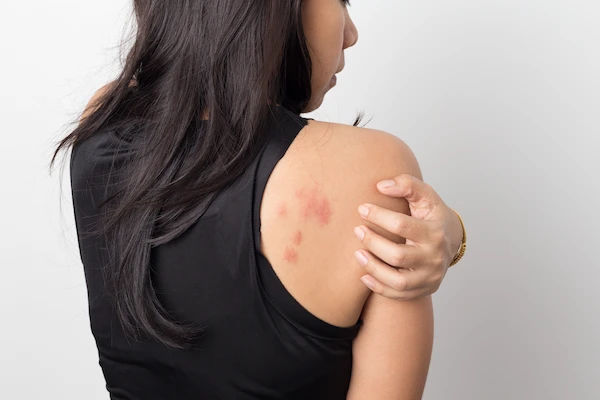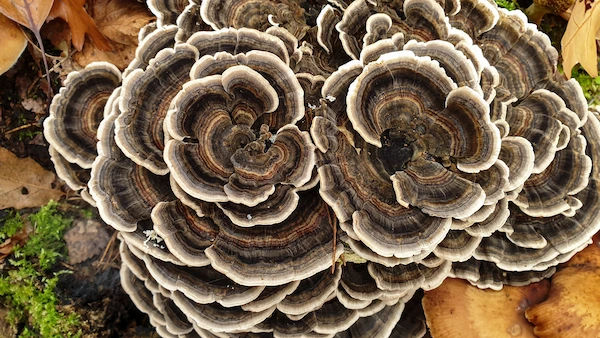How to Reduce Redness on Face?
Discover causes, treatments, and skincare tips for facial redness. Learn how to manage redness with home remedies, OTC products, and lifestyle changes.

Written by
Last updated on 3rd Jul, 2025
Facial redness is a condition where the skin of the face appears flushed or red. Usually, bacterial and fungal infections are the reasons behind this condition, but in some cases, chronic skin conditions like eczema can be responsible as well. Apart from that, some of the common causes of facial redness are rosacea, seborrheic dermatitis, allergic reactions, psoriasis, etc. Facial redness is typically a temporary condition, and it is not threatening. However, when it persists or recurs, it is crucial to get it checked to avoid the development of any serious issues.
Identifying Triggers
Certain environmental conditions can often exacerbate facial redness. Some examples are –
Air pollution
Sunlight (UV radiation exposure)
Humidity or dry wind
Use of harsh makeup products
Some specific foods and drinks can also trigger facial rashes. Examples include –
Spicy and sugary foods
Alcohol, particularly red wine
Processed meats
Dairy products
Sometimes, lifestyle habits can also aggravate the facial rash. These include –
Smoking
Excessive stress
Rigorous exercise
Skincare Routine Adjustments
Knowing the skin type is necessary before deciding on a skincare regime to combat facial redness. Generally, facial skin is categorised as dry, oily, sensitive, or having a combination or normal texture. Depending on the skin type, the products vary and can be used to manage conditions like acne, ageing, hyperpigmentation, etc. The efficacy of the product largely depends on its ingredients. For example, hyaluronic acid hydrates the skin, whereas vitamin C contributes largely to skin brightening.
So, here are some examples of skincare products for each skin type –
Dry Skin: Cetaphil Gentle Skin Cleanser, Cocokind Rosewater Facial Toner, The Ordinary Hyaluronic Acid 2% + B5, Neutrogena Hydro Boost Water Gel Lotion Sunscreen.
Oily Skin: Kiehl’s Rare Earth Deep Pore Daily Cleanser, Paula’s Choice Skin Balancing Pore-Reducing Toner, CeraVe PM Facial Moisturising Lotion, Neutrogena Pink Grapefruit 100% Hydrogel Mask.
Sensitive Skin: CeraVe Moisturising cream, Hydrating Hyaluronic Acid Serum, Himalaya Purifying Neem Face Wash, Neutrogena Hydro Boost Cleanser Water Gel.
Combination Skin: Laurel Skin Deep Clarity Oil Cleanser, Pixi Glow Tonic, Glow Recipe Avocado Ceramide Redness Relief Serum, Neutrogena Hydro Boost Gel-Cream.
Normal Skin: Cetaphil Gentle Skin Cleanser, The Ordinary Hyaluronic Acid 2% + B5, Neutrogena Hydro Boost Water Gel, Supergoop Unseen Sunscreen.
Apart from allergic substances, some other potentially toxic chemicals must not be used under any condition. These are –
Methyl and propyl parabens
Phthalates
Aluminium
Formaldehyde
Oxybenzone
PEGs (polyethylene glycols)
Besides the products, one needs to inculcate some healthy skincare habits. These are –
Cleansing twice a day
Putting serums in the morning
Moisturising as and when needed
Applying sunscreen while going outdoors
Medical Treatments
In some cases, the facial redness becomes so persistent that simple skincare is insufficient to resolve it. Then comes the need to bring over-the-counter (OTC) medicines. Some commonly used creams and gels are –
Calamine Lotion
Aloe Vera Gel
Hydrocortisone Cream
Green tea extract creams or gels
Niacinamide-based creams like CeraVe PM Facial Moisturizing Lotion
If the condition is chronic and OTC medications fail, then comes the need to consult a healthcare provider. After examining the patient, the dermatologist prescribes the medication needed. Some common ones are –
Metronidazole (topical)
Clindamycin (topical)
Isotretinoin (oral)
Antibiotics like doxycycline, tetracycline (oral)
Professional dermatological treatments are fetched when the condition is severe, like in the case of rosacea, chronic acne, etc. In such cases, the patient has to undergo extensive treatment procedures, which can be time-consuming and painful. The options here are –
Cryotherapy
Application of topical steroid
Pulse Dye Laser (PDL)
Chemical Peels
Sclerotherapy
Natural Remedies
Sometimes, the facial rashes can also be reduced with natural remedies. But, this is only possible if the dermatological condition is temporary and not so severe. Some simple and gentle remedies that can be practised at home are –
Applying rosewater
Using coconut oil
Applying fresh aloe vera gel extracted from the plant
Using green tea extracts
Applying raw honey on the face for 10 to 15 minutes
Applying chilled cucumber slices or juice directly
Various types of facials and masks are available in the market. If the right product is selected based on the skin type, it not only gives a soothing effect but nourishes the skin. The benefits of using these are –
Helps in exfoliation
Increases hydration
Helps in deep cleansing
Unclogs the pores
Relieves stress
Enhances skin health
Improves skin tone
Dietary and Hydration Tips
Facial rashes are often caused due to inadequate water intake and poor dietary habits. Irrespective of the skincare products and topical treatments, improper hydration will affect the skin and its texture. So, drinking the required water is needed to maintain healthy skin. Proper hydration flushes out toxins from the body and provides a clear and supple skin.
Besides hydration, dietary habits can also affect the skin's natural appearance. So, for clear and glowing skin, one must include the following food items in his/her diet –
Avocados
Fatty fish
Carrots
Walnuts
Soybeans
Dark Chocolate
Lifestyle Changes
Poor facial skin condition is often triggered by lifestyle factors like chronic and excessive stress. While the demands of modern life often lead to excessive strain, it is possible to manage it through a few changes like –
Meditation
Deep breathing
Regular exercise
Better time management
Indulging in hobbies
Besides stress, sleep deprivation also leads to damaged skin. It impairs the function of the skin barrier, resulting in increased redness, inflammation, rashes, etc. During sleep, the body repairs the damages naturally, and inadequate sleep disrupts this process. Therefore, to maintain healthy skin, sufficient sleep is necessary.
When to See a Dermatologist?
Facial redness can happen for many reasons. But when is a professional intervention needed? Here are some signs that call for a consultation with a healthcare provider –
If the redness is persistent
Itchiness is increasing
The rash is becoming severe
Skin texture is changing drastically
How to Prepare For a Dermatologist Appointment?
To prepare for an appointment with a dermatologist, one needs to keep the following in mind –
Keeping track of the symptoms, their duration, triggers, etc.
Listing the medications and skin care products used recently
Listing medical history and previous treatments
Noting down the questions and concerns
Understanding Rosacea
Rosacea is a common chronic inflammatory skin disease that largely affects the facial skin. The cheeks, nose, and forehead are mostly affected by this condition.
Rosacea can be genetic or triggered by environmental factors. Additionally, eating spicy foods and lingering sun exposure or excessive and chronic stress can further worsen this condition.
Rosacea can be quite painful as persistent flushing, acne-like bumps, and severe redness accompany it. A dermatologist consultation is absolutely necessary for a person affected by rosacea.
How to Manage Rosacea?
Changing the lifestyle, adapting appropriate topical treatment, and avoiding the known causes that trigger the condition can help manage it. However, patience is also needed as this condition takes time to cure.
Conclusion
Facial redness is a common yet harmless skin condition that everyone experiences at some point in their lives. Typically, this is a temporary skin condition that resolves itself, but in cases where it is persistent or chronic, it must not be neglected. And, if it is rosacea, it becomes a primary concern, needing immediate healthcare supervision. Facial redness is easily manageable through home remedies, lifestyle changes and over-the-counter medications, but prescribed medicines are necessary for severe cases. However, individuals should focus on prevention rather than cure. With the right diet and proper hydration, they can easily improve the quality of their skin and prevent developing redness. Also, in terms of lifestyle changes, they can focus on reducing stress and getting enough sleep to ensure their skin remains healthy and devoid of any undue conditions that disrupt their life.
Consult Top Dermatologist
Consult Top Dermatologist

Dr. Benugopal Mohapatra
Dermatologist
9 Years • MBBS, DNB (Derm, Ven & Lep)
Kolkata
arati medical and polyclinic, Kolkata

Dr. Somshukla Ray
Dermatologist
10 Years • MBBS, MD (Dermatology,Venerology & Leprosy), DNB (Dermatology,Venerology & Leprosy)
Kolkata
MCR SUPER SPECIALITY POLY CLINIC & PATHOLOGY, Kolkata
(25+ Patients)

Dr Shailaja Pm
Dermatologist
26 Years • MBBS, DIPLOMA IN DERMATOLOGY, VENEREOLOGY AND LEPROSY, FAM
Bengaluru
Sri Siri Skin Aesthetic and Hair Transplantation Clinic, Bengaluru

Dr. B Srujana
Dermatologist
12 Years • MBBS, MD Dermatology, Venereology & Leprosy
Hyderabad
DermaPro Clinic, Hyderabad

Dr. Bhavyashree U G
Dermatologist
14 Years • MBBS, MD Dermatology, Venereology & Leprosy
Bengaluru
Bhavyas skin and hair center, Bengaluru



